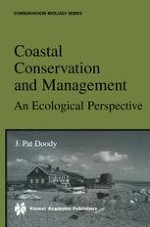2001 | OriginalPaper | Chapter
Ecological Networks
Author : J. Pat Doody
Published in: Coastal Conservation And Management
Publisher: Springer Netherlands
Included in: Professional Book Archive
Activate our intelligent search to find suitable subject content or patents.
Select sections of text to find matching patents with Artificial Intelligence. powered by
Select sections of text to find additional relevant content using AI-assisted search. powered by
Mobile species may rely on one or more habitats during the course of their life cycle and these may be spatially separated by a few metres or several thousand kilometres. Previous chapters have described the important spatial and temporal relationships between and within coastal habitats. These include sometimes complex ecological and geomorphological links where external forces may force rapid change. The management of an individual site can also fundamentally alter the nature of the component habitats and all these factors can influence the value of the area to visiting species. When considering the conservation of a mobile species it is important, therefore, to understand the individual habitat and feeding requirements at the different stages in its life cycle. This is particularly important for those species with special needs when breeding (e.g. sea cliffs for sea birds, shallow dune slacks for natterjack toad or saltmarsh with a good structural diversity for redshank), or feeding habitat (e.g. estuary mudflats for wintering waders or saline lagoons for the flamingo). Those species which are more catholic in their tastes are less dependent on specific habitats and therefore more resistant to change.
